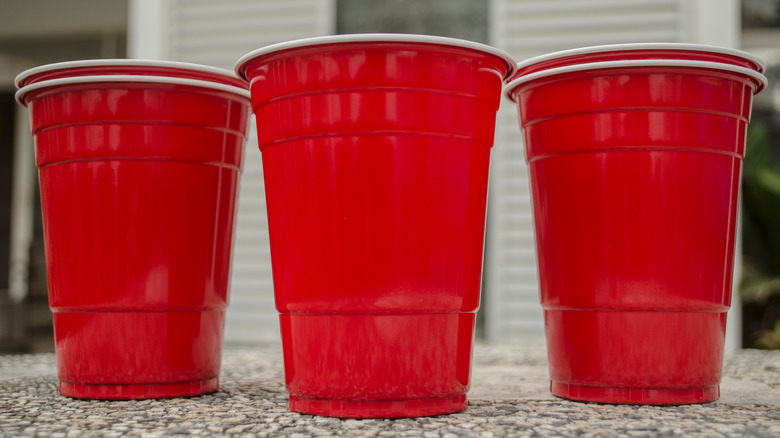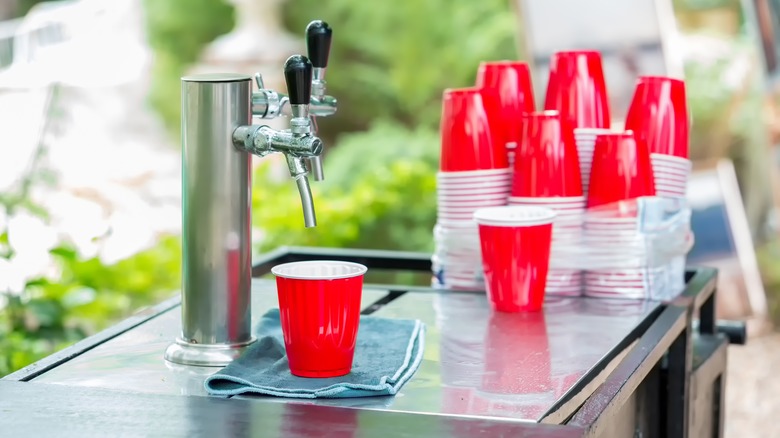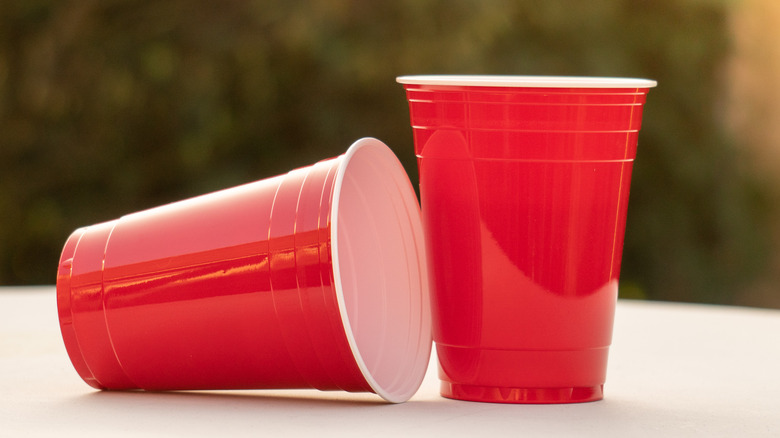The Lines On SOLO Cups Mean More Than You Think
Whether you're tailgating ahead of the big game or simply celebrating the return of another Friday night, no party is complete without a stack of red Solo cups. The plastic drinkware has been the go-to receptacle for beverages – alcoholic or otherwise – since its release in the 1970s, nearly 40 years after Robert Leo Hulseman founded the SOLO cup company in 1936 (via SOLO).
These days, the iconic cups are practically synonymous with partying, lending themselves to cocktail mixing, shot taking, and drinking games like flip cup and beer pong. You've likely used a few yourself if you've ever attended a soiree that served some sort of liquid refreshments, or have at least seen a few photos of people holding them pop up on your social media feeds. If that's true, you're likely also familiar with the drinkware's age-old design that consists of lines that land roughly at the 1-, 5-, and 12-oz measurements on the 16-oz cup (via Taste of Home).
The pattern is no longer the standard for SOLO brand cups, which were redesigned with a square shape that the brand says will help "minimize slippage and spills," per its FAQ page. Even so, the previous trio of lines is the subject of a popular social media theory. Though, like many things on the internet, the viral SOLO cups rumor isn't all fact.
Don't believe this myth about the SOLO cup's original design
If you've logged onto any of the major social media platforms in the last decade, you may have seen a graphic detailing the meaning behind the original design of the iconic red SOLO cup. According to Taste of Home, the viral post claims that the trio of lines around the exterior of the receptacle that fall around the 1-, 5-, and 12-oz marks are meant to aid users in pouring alcoholic beverages, with the first line representing the standard pour for liquor, the second for wine, and the third for beer. At first read, this makes perfect sense, but upon fact-checking the viral social media claim, Politifact found it to be nothing but a coincidence.
While the three lines do roughly match the CDC's recommended measurements for adult beverages, which are 1.5, five, and 12 ounces for liquor, beer, and wine, respectively, that was not Robert Leo Huselman's intent for them when he designed the drinkware. "When SOLO designed the iconic red cup in 1976, every detail served a purpose and still does to this day," Margo Burrage, director of communications for SOLO's parent company, Dart Container Corporation, said in an email to Politifact in 2019. Burrage confirmed that the lines were not meant to help measure out beverages, though they "were a quite purposeful part of the design." Here's what SOLO says is the true meaning behind its original design.
Those lines were originally meant to prevent slippage
As Toby Keith said in his ode to Robert Leo Huselman's iconic drinkware, the red SOLO cup is "more than just plastic, you're more than amazing, you're more than fantastic" (via YouTube). This certainly rings true once you hear about the many purposes for the boldly-colored receptacle's original design, which consisted of a set of three lines around the one, five, and 12-oz measurements on the cup. In an email to Politifact, director of communications for SOLO's parent company, Dart Container Corporation, Margo Burrage explained that the actual, original reason behind the trio of lines was to prevent slippage while holding the cup. However, over the years, the design has gone on to "mean something different for everyone" (via SOLO).
A graphic posted to the company's Facebook page back in 2012 claimed that the bottom line on the cup was to help measure chocolate syrup for the perfect glass of chocolate milk, though it could also be used for mouthwash. SOLO suggested that the 5-ounce line marked the recommended juice serving for youngsters, but could also be used to measure cereal. Meanwhile, many used the 12-oz marking as a guide to how much water they should drink five times a day, though the company claimed that it could also be helpful in curating a delicious Shirley Temple. And while not their original purpose, the company does support the idea of using the lines to pour a responsible drink, as well.


